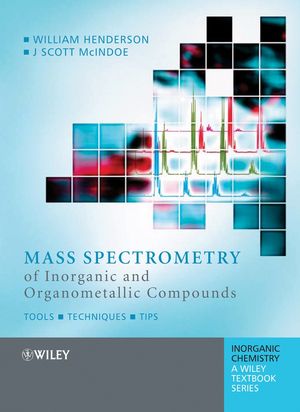Mass Spectrometry of Inorganic and Organometallic Compounds: Tools - Techniques - TipsISBN: 978-0-470-85015-2
Hardcover
272 pages
February 2005
 |
||||||
List of commonly-used abbreviations.
1. Fundamentals.
1.1 Introduction.
1.2 Inlets.
1.3 Collision-induced dissociation.
1.4 Detectors.
1.5 Mass resolution.
1.6 Data processing.
1.7 Isotopes.
References.
2. Mass analysers.
2.1 Introduction.
2.2 Sectors.
2.3 Quadrupoles.
2.4 Quadrupole Ion Trap.
2.5 Time-of-flight.
2.6 Fourier Transform Ion Cyclotron Resonance.
References.
3. Ionisation techniques.
3.1 Introduction.
3.2 Electron ionisation.
3.3 Chemical Ionisation.
3.4 Field ionisation / Field desorption.
3.5 Plasma Desorption.
3.6 Fast Atom Bombardment / Liquid Secondary Ion Mass Spectrometry.
3.7 Matrix Assisted Laser Desorption Ionisation.
3.8 Inductively Coupled Plasma Mass Spectrometry.
3.9 Electrospray ionisation.
References.
4. The ESI MS behaviour of simple inorganic compounds.
4.1 Introduction.
4.2 Simple metal salts.
4.3 Polyanions formed by main group elements.
4.4 Oxoanions formed by main group elements.
4.5 Borane anions.
4.6 Fullerenes.
4.7 Inorganic phosphorus compounds: phosphoranes and cyclophosphazenes.
4.8 Summary.
References.
5. The ESI MS behaviour of coordination complexes.
5.1 Introduction.
5.2 Charged, "simple" coordination complexes.
5.3 (Neutral) metal halide coordination complexes.
5.4 Metal complexes of polydentate oxygen donor ligands: polyethers, crown ethers, cryptands and calixarenes.
5.5 Porphyrins and metalloporphyrins.
5.6 Metal alkoxides – highly moisture-sensitive coordination compounds.
5.7 b-Diketonate complexes.
5.8 Metal complexes of carbohydrates.
5.9 Metal complexes of amino acids, peptides and proteins.
5.10 Oxoanions, polyoxoanions and related species.
5.11 Metal clusters.
5.12 Compounds with anionic sulfur and selenium donor ligands.
5.13 Characterisation of metal-based anticancer drugs, their reaction products and metabolites.
5.14 In situ formation of coordination complexes as an ionisation technique.
5.15 Summary.
References.
6. The ESI MS behaviour of main group organometallic compounds.
6.1 Introduction.
6.2 Organometallic derivatives of group 14 elements.
6.3 Organometallic derivatives of group 15 elements.
6.4 Organometallic derivatives of group 16 elements; organo-sulfur, -selenium and -tellurium compounds.
6.5 Organomercury compounds.
6.6 Other organometallic derivatives.
6.7 Summary.
References.
7. The ESI MS behaviour of transition metal and lanthanide organometallic compounds.
7.1 Introduction.
7.2 Metal carbonyl complexes.
7.3 Metal isocyanide complexes.
7.4 Metal cyclopentadienyl and related complexes.
7.5 Metal h3-allyl complexes.
7.6 Metal arene complexes.
7.7 Formation of p-hydrocarbon complexes and their use as an ionisation aid.
7.8 Metal-acetylene/acetylide complexes, and complexes of metal-acetylides.
7.9 Transition metal s-alkyl and aryl complexes.
7.10 Mass spectrometry of lanthanide organometallic complexes.
7.11 Summary.
References.
8. A selection of special topics.
8.1 Introduction.
8.2 Characterisation of dendrimers using ESI and MALDI–TOF MS techniques.
8.3 Investigating the formation of supramolecular coordination assemblies using ESI MS.
8.4 Using ESI MS as a tool for directing chemical synthesis: A case studyinvolving the platinum metalloligands [Pt2(m–E)2(PPh3)4] (E = S, Se).
8.5 Applications of ESI MS in the detection of reactive intermediates and catalyst screening.
References.
Appendix 1: Naturally occurring isotopes.
Appendix 2: Periodic table of the elements.
Appendix 3: Alphabetical list of elements.
Appendix 4: Glossary of Terms.
Appendix 5: Useful sources of information.
Index.



